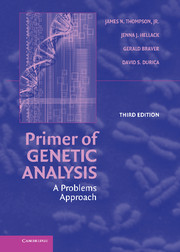Book contents
- Frontmatter
- Contents
- Preface
- Note on Genetic Symbols
- 1 Overview of Genetic Organization and Scale
- 2 Mitosis and Meiosis
- 3 Nucleic Acids: DNA and RNA
- 4 Basic Mendelian Genetics
- 5 Probability and Chi-Square
- 6 Sex-Linkage and Gene Interactions
- 7 Pedigree Analysis
- 8 Overview of Basic Statistical Testing
- 9 Quantitative Inheritance
- 10 Overview of Genetic Mapping
- 11 Assessing Chromosome Linkage Relationships
- 12 Linkage and Mapping in Diploids
- 13 Mapping in Bacteria and Viruses
- 14 Overview of Types of Genetic Change
- 15 Gene Mutation
- 16 Changes in Chromosome Number and Structure
- 17 Protein Synthesis and the Genetic Code
- 18 Gene Regulation and Development
- 19 Overview of Molecular Biology Techniques
- 20 DNA Mapping and Human Genome Analysis
- 21 Basic Population Genetics
- 22 Selection and Evolution
- 23 Practice Tests
- 24 Answers to Practice Tests and Crossword Puzzles
- 25 Landmarks in the History of Genetics
- Glossary
- Reference Tables
2 - Mitosis and Meiosis
Published online by Cambridge University Press: 05 June 2012
- Frontmatter
- Contents
- Preface
- Note on Genetic Symbols
- 1 Overview of Genetic Organization and Scale
- 2 Mitosis and Meiosis
- 3 Nucleic Acids: DNA and RNA
- 4 Basic Mendelian Genetics
- 5 Probability and Chi-Square
- 6 Sex-Linkage and Gene Interactions
- 7 Pedigree Analysis
- 8 Overview of Basic Statistical Testing
- 9 Quantitative Inheritance
- 10 Overview of Genetic Mapping
- 11 Assessing Chromosome Linkage Relationships
- 12 Linkage and Mapping in Diploids
- 13 Mapping in Bacteria and Viruses
- 14 Overview of Types of Genetic Change
- 15 Gene Mutation
- 16 Changes in Chromosome Number and Structure
- 17 Protein Synthesis and the Genetic Code
- 18 Gene Regulation and Development
- 19 Overview of Molecular Biology Techniques
- 20 DNA Mapping and Human Genome Analysis
- 21 Basic Population Genetics
- 22 Selection and Evolution
- 23 Practice Tests
- 24 Answers to Practice Tests and Crossword Puzzles
- 25 Landmarks in the History of Genetics
- Glossary
- Reference Tables
Summary
STUDY HINTS
Genes are located on chromosomes, and the stable manner in which chromosomes are first replicated and then distributed to daughter cells during cell division is the basis for genetic inheritance. Since much of genetic theory is based on the behavior of chromosomes and the genes they carry, it is very important to understand clearly how nuclear division occurs. In this way you can predict its consequences and understand the effect of errors that might occur in it. Yet the subject of cell division is complex, with many new terms to memorize and numerous things happening simultaneously. It is a continuous process that has been divided into stages somewhat artificially, so that we can describe it conveniently. All of this makes it rather hard to grasp at the beginning. Do not despair! It is really much simpler than it looks at first. The secret is to learn in stages. First one must understand the “strategies” of mitosis and meiosis, and the differences between them.
Mitosis has evolved as a mechanism to distribute accurately a copy of each chromosome present in the original cell to two new cells. The “goal” of meiosis is quite different. Meiosis passes alternate (homologous) copies of each type of chromosome to daughter cells and reduces the total chromosome number by half. These different objectives require slightly different chromosome behaviors. We shall briefly summarize these two processes, keeping in mind the different strategies they represent.
- Type
- Chapter
- Information
- Primer of Genetic AnalysisA Problems Approach, pp. 6 - 17Publisher: Cambridge University PressPrint publication year: 2007

